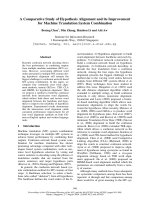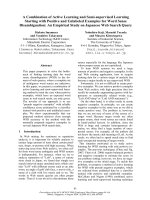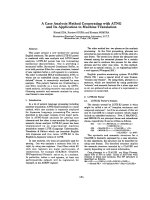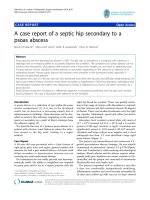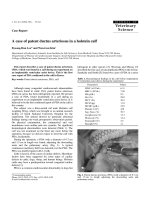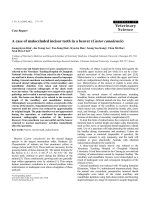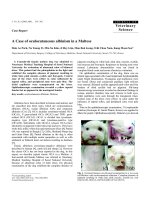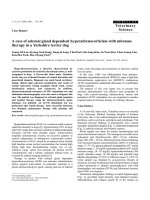báo cáo khoa học: "A rare combination of an endocrine tumour of the common bile duct and a follicular lymphoma of the ampulla of Vater: a case report and review of the literature" ppt
Bạn đang xem bản rút gọn của tài liệu. Xem và tải ngay bản đầy đủ của tài liệu tại đây (383.23 KB, 4 trang )
CAS E REP O R T Open Access
A rare combination of an endocrine tumour of
the common bile duct and a follicular lymphoma
of the ampulla of Vater: a case report and review
of the literature
Panagiotis G Athanasopoulos
1*
, Nikolaos Arkadopoulos
4
, Vania Stafyla
4
, Aliki Tympa
2
, Evi Kairi
3
,
Charlotte Ryzman-Louloudis
1
, Vassilios Smyrniotis
4
Abstract
Carcinoid tumours of the common bile duct represent an extremely rare entity. Similarly, primary follicular
lymphomas of the ampulla of Vater constitute an infrequent neoplasia. Herein, we report the first case of a
synchronous development of a carcinoid tumour of the common bile duct and an ampullary follicular lymphoma
that was treated surgically with a Whipple’s procedure, due to inability to establish definitive preoperative
diagnosis despite the extensive diagnostic investigation.
Background
Carcinoid tumours of the extrahepatic bile duct (EHBD)
represent extremely rare lesions. These neoplasms
account for 0.1% to 0.3% of all gastrointestinal carcinoid
tumours [1]. Unlike cholangiocar cinomas, bile duct car-
cinoids occur more commonly in younger patients and
in women [2]. Altogether, 70 patients with carcinoid
tumours arising from the biliary tree have been reported
in the literature [3]. Similarly, follicular lymphomas of
the ampulla of Vater represent an infrequent entity
accounting for only 1-3.8% of all gastrointestinal lym-
phomas [4] with only a few cases reported in the litera-
ture [4,5]. Interestingly, these cases most commonly
occured in women. We report the first case of a syn-
chronous carcinoid tumour of the EHBD and an ampul-
lary follicular lymphoma that was treated surgically.
Case Presentation
A 43-year old Caucasian male with no remarkable
medical history, was referred to our clinic with inter-
mittent jaundice and a 1-month history of nausea,
vomiting, pruritus, dark urine, clay-colored stools and
weight loss of 5 kg. The patient did not report abdom-
inal pain or decreased appetite.
On admission, the patient’s liver functio n tests (LFTs)
were abnormal; aspartate aminotransferase (AST) 78 IU/
L (normal, < 45 IU/L), alanine aminotransferase (ALT)
109 IU/L (normal, < 45 IU/L), alkaline phosphatase
(ALP) 226 IU/L (normal, 40-150 IU/L), g-glutamyl
transpeptidase (gGT) 932 IU/L (normal, 10-55 IU/L),
total bilirubin 1.3 mg/dl (normal, 0.21-1.2 mg/dl) and
direct bilirubin 0.9 mg/dl (normal, < 0.5 mg/dl), while
the tumour marker s CEA, CA 19-9 and A FP were
within normal range.
Contrast enhanced computed tomog raphy (CT) of the
abdomen revealed dilatation of the biliary tree, with the
hepatic duct measuring a diameter of 1.8 cm. Neither
lymph node enlargement nor splenomegaly was demon-
strated. Magnetic resonance cholangiopancreatography
(MRCP) showed dilated intrahepatic and extrahepatic
bile ducts including the cystic duct and the gallbladder.
The common bile duct (CBD) measured 1.4 cm in dia-
meter with a n abrupt concentric stenosis in its lower
third and a cut-off point located 1 cm distally to the
duodenal ampulla. The pancreatic duct was depicted as
normal (Figure 1).
* Correspondence:
1
Department of Surgery, University of Athens, Aretaieion Hospital, 76 Vas.
Sofias Ave., 11528, Athens, Greece
Full list of author information is available at the end of the article
Athanasopoulos et al. World Journal of Surgical Oncology 2011, 9:4
/>WORLD JOURNAL OF
SURGICAL ONCOLOGY
© 2011 Athanasopoulos et al; licensee BioMed Central Ltd. This is an Ope n Acces s article distributed under the terms of the Creative
Commons Attribution License ( , which permits unrestricted use, distribution, and
reproduction in any medium, provided the original work is properly cited.
Endoscopic ultrasonography (EUS) demonstrated the
duodenal ampulla of Vater thickened and the CBD
dilated with the presence of thick content.
The patient underwent an endosco pic retrograde cho-
langiopancreatography (ERCP). The ampulla of Vater
was depicted as being infiltrated by t he neoplasm. An
endoscopic sphincterotomy was carried out, thus letting
us better view and sample the region, and the biopsies
taken revealed the presence of an undif ferentiated neo-
plasm, but no definitive diagnosis was made.
Taking into consideration the aforementioned find-
ings, our decision was to operate on the patient, and we
performed a pylorus-preserving pancreaticoduodenect-
omy with the en bloc resection of the area in question
and surrounding structures, including the regional
lymph nodes.
Histopathological and immunohistochemical study of
the surgical specimen revealed infiltration of the duode-
num by a non-Hodgkin B cell lymphoma, predominantly
of nodular type, with characteristics of grade I follicular
lymphoma [World Health Organization (WHO) classifi-
cation] with G(l)+ clonicity and indicative immunohis-
tochemical examination (CD 10+, bcl-2-) (Figure 2). In
addition, an intramucosal carcinoid of the CBD, measur-
ing a diameter of 0.3 cm, was ide ntified. All eight
excised lymph nodes were normal (Figure 3).
Postoperatively, the patient was further staged.
Regarding the lymphoma, we conducted a CT scan of
the neck and chest as w ell as a bone marrow biopsy to
exclude extra-enteric lesions, and we proceeded with a
video capsule endoscopy in order to exclude multifocal
involvement of the small intestine [6]. All these addi-
tional exams yielded no findings. As far as the carcinoid
was concerned, the levels of the ne uroendocrine mar-
kers 5-HIAA (5-hydroxy indoleacetic acid), CgA (chro-
mogranin A) and NSE (neuron-specific enolase) were
found within normal range. Because of the small size
and histology of the carcinoid, no other imaging modal-
ities such as Octreoscan or MIBG (meta-iodobenzylgua-
nidine) scintigraphy were used [7].
The follow-up of the patient includes a complete
bloo d count, routine biochemical exams and an abdom-
inal CT scan every six months af ter surgery, supported
with an annual evaluation of CgA levels [6,7]. Eighteen
months after the resection, neither the lab tests nor the
imaging t echniques have revealed any recurrence of the
disease nor has the patient referred any symptoms.
Figure 1 MRCP depicting the dilatation and abrupt stenosis of
the CBD, close to the ampulla of Vater (arrow).
Figure 2 Histological section of the duodenum showing a
lymphoproliferative lesion consistent with a non-Hodgkin
lymphoma (Hematoxylin & Eosin, ×250).
Figure 3 Histological section of Vater’ s ampulla showing a
carcinoid with insular pattern (H&E, ×250).
Athanasopoulos et al. World Journal of Surgical Oncology 2011, 9:4
/>Page 2 of 4
Discussion
Carcinoid tumours arise f rom enterochromaffin cells,
also known as argentaffin or Kulchitsky cells. The term
enterochromaffin refers to the ability to stain with
potassium chromate (chromaffin), a feature of cells that
contain serotoni n. These cells are located in the gastro -
intestinal tract (most commonly in the small intestine,
appendix and rectum) [1] or at various sites within the
respiratory tract [8] or the pelvic cavity (uterine cervix,
ovary, testis), the oto-laryngeal region and the breast [9].
A small number of these cells also exist in the biliary
tree [10]. The rarity of carcinoid tumours in this region
areprobablyexplainedbytheverylimitednumberof
the Kulchitsky cells [11]. Carcinoid tumours of the
EHBD account for only 0.1-0.3 of all gastrointestinal
carcinoids [1].
The term ‘carcinoi d tumour’ has been replaced by the
term ‘well-differentiated endo crine tumour’ in the latest
WHO classification of tumours (IARC, Lyons, France,
2000). The malignancy of neuroendocrine tumours is
well described, ranging from well-differentiated tumours
to malignant neoplasms [1,12].
The WHO staging system is based on the criteria such
as tumour size, histological differentiation, Ki-67 immu-
nostaining, invasion of adjacent tissues, and vascular
and perineural invasion.
Available data extrapolated from the existing literature
suggest that carcinoid tumours of the extrahepatic bili-
ary tree are of low malignancy [13]. However, these neo-
plasms tend to metastasize if remain untreated [9].
Complete resection of localized tumours, without metas-
tases, results in a 5-year survival of 60-100% [1,14] thus
proposing aggressive surgical management as an optimal
treatment modality. In contrast, radiotherapy offers no
benefit and chemotherapy has been used only in metas-
tastic disease with too few reports to support any defini-
tive conclusions [15].
Primary gastrointestinal non-Hodgkin lymphomas
(NHL)constitutemorethanone-thirdofallextranodal
lymphomas. The stomach is the most common site, fol-
lowed by the colorectal region and the terminal ileum
[16]. The duodenum is less frequently affected. The vast
majority (80-90%) of primary gastrointestinal lympho-
mas originate from B cells and include diffuse large B
cell lymphoma (DLBCL) and mucosa-associated lym-
phoid tissue (MALT) lymphoma, whereas follicular lym-
phomas have a reported incidence of 1-3.8% [4].
Compared to other biliary malignancies, lymphomas
are more sensitive to chemotherapy and radiotherapy.
However, NHLs represent a rare cause of malignant bili-
ary obstruction, accounting for 1-2% of all cases [17],
thus making medical decision-making a challenging pro-
cedure. Lymphomas of the periampullary region causing
obstructive jaundice could be treated with chemotherapy
provided that biliary drainage has been established
securely through stenting of the CBD. Carcinoid
tumours o f the EHBD and ampullary follicular lympho-
mas, constitute exceedingly rare neoplasms. We herein
report the first case of a synchronous development of
these two malignancies that was treated surgically.
Unlike most cases in the literature, where both
carcinoids and follicular lymphomas exhibited a female
predominance, our case refers to a 43-year-old male.
Althoughtheroleofsurgeryforgastrointestinal
lymphomas is not the treatment of choice, in our case
resection was obligatory since the endoscopic biopsies
were inconclusive.
Conclusion
We present a patient harbouring a periampullar y neo-
plasm, causing obstructive jaundice. We proce eded with
a pancreaticoduodenectomy based on the preoperative
finding of a poorly undifferentiated periampullary neo-
plasm. However, the final diagnosis revealed a follicular
lymphoma of the duodenum and a carcinoid tumour of
the CBD. No adjuvant therapy was judged appropriate
after thorough staging and the patient is doing well
eighteen months after surgery.
Consent
Written informed consent was obtained from the patient
for publication of this case report and any accompany-
ing images. A copy of the written c onsent is available
for review by the Editor-in-Chief of this journal.
Author details
1
Department of Surgery, University of Athens, Aretaieion Hospital, 76 Vas.
Sofias Ave., 11528, Athens, Greece.
2
Department of Anesthesiology,
University of Athens, Aretaieion Hospital, 76 Vas. Sofias Ave., 11528, Athens,
Greece.
3
Department of Pathology, University of Athens, Aretaieion Hospital,
76 Vas. Sofias Ave., 11528, Athens, Greece.
4
4thDepartment of Surgery,
University of Athens, Attikon Hospital, 1 Rimini Street, Chaidari 12462,
Athens, Greece.
Authors’ contributions
PA carried out the surgical procedure, designed the study, gathered the
data and wrote the manuscript. NA finally revised the manuscript for
submission. VSt participated in drafting and revising the manuscript. AT
participated in gathering the data and drafted the manuscript. EK performed
the appropriate histological analysis of the surgical specimens and provided
histological sections as figures for the manuscript. CRL revised the language
of the manuscript as a native English speaker. VS carried out the surgical
procedure, participated in designing the study and revised the manuscript
for submission. All authors have read and approved the final manuscript.
Competing interests
The authors declare that they have no competing interests.
Received: 14 October 2010 Accepted: 14 January 2011
Published: 14 January 2011
References
1. Modlin IM, Lye KD, Kidd M: A 5-decade analysis of 13,715 carcinoid
tumors. Cancer 2003, 97:934-959.
Athanasopoulos et al. World Journal of Surgical Oncology 2011, 9:4
/>Page 3 of 4
2. Kopelman D, Schein M, Kerner H, Bahuss H, Hashmonai M: Carcinoid tumor
of the common bile duct. HPB Surg 1996, 10:41-43.
3. Squillaci S, Marchione R, Piccolomini M, Colombo F, Bucci F, Bruno M,
Bisceglia M: Well-differentiated neuroendocrine carcinoma (malignant
carcinoid) of the extrahepatic biliary tract: report of two cases and
literature review. APMIS 2010, 118:543-556.
4. Yoshino T, Miyake K, Ichimura K, Mannami T, Ohara N, Hamazaki S, Akagi T:
Increased incidence of follicular lymphoma in the duodenum. Am J Surg
Pathol 2000, 24:688-693.
5. Misdraji J, Fernandez del Castillo C, Ferry JA: Follicle center lymphoma of
the ampulla of Vater presenting with jaundice: report of a case. Am J
Surg Pathol 1997, 21:484-488.
6. Boot H: Diagnosis and staging in gastrointestinal lymphoma. Best Pract
Res Clin Gastroenterol 2010, 24:3-12.
7. Kocha W, Maroun J, Kennecke H, Law C, Metrakos P, Ouellet JF, Reid R,
Rowsell C, Shah A, Singh S, Van Uum S, Wong R: Consensus
recommendations for the diagnosis and management of well-
differentiated gastroenterohepatic neuroendocrine tumours: a revised
statement from a Canadian National Expert Group. Curr Oncol 2010,
17:49-64.
8. Are C, Gonen M, D’Angelica M, DeMatteo RP, Fong Y, Blumgart LH,
Jarnagin WR: Differential diagnosis of proximal biliary obstruction. Surgery
2006, 140:756-763.
9. Modlin IM, Shapiro MD, Kidd M: An analysis of rare carcinoid tumors:
clarifying these clinical conundrums. World J Surg 2005, 29:92-101.
10. Christie AC: Three cases illustrating the presence of argentaffin
(kultschitzky) cells in the human gall-bladder. J Clin Pathol 1954,
7:318-321.
11. Barron-Rodriguez LP, Manivel JC, Mendez-Sanchez N, Jessurun J: Carcinoid
tumor of the common bile duct: evidence for its origin in metaplastic
endocrine cells. Am J Gastroenterol 1991, 86:1073-1076.
12. Modlin IM, Sandor A: An analysis of 8305 cases of carcinoid tumors.
Cancer 1997, 79:813-829.
13. Maitra A, Krueger JE, Tascilar M, Offerhaus GJ, Angeles-Angeles A,
Klimstra DS, Hruban RH, Albores-Saavedra J: Carcinoid tumors of the
extrahepatic bile ducts: a study of seven cases. Am J Surg Pathol 2000,
24:1501-1510.
14. Skogseid B, Grama D, Rastad J, Eriksson B, Lindgren PG, Ahlstrom H,
Lorelius LE, Wilander E, Akerstrom G, Oberg K: Operative tumour yield
obviates preoperative pancreatic tumour localization in multiple
endocrine neoplasia type 1. J Intern Med 1995, 238:281-288.
15. Podnos YD, Jimenez JC, Zainabadi K, Ji P, Cooke J, Busuttil RW,
Imagawa DK: Carcinoid tumors of the common bile duct: report of two
cases. Surg Today 2003, 33:553-555.
16. Cirillo M, Federico M, Curci G, Tamborrino E, Piccinini L, Silingardi V:
Primary gastrointestinal lymphoma: a clinicopathological study of 58
cases. Haematologica 1992, 77:156-161.
17. Odemis B, Parlak E, Basar O, Yuksel O, Sahin B: Biliary tract obstruction
secondary to malignant lymphoma: experience at a referral center. Dig
Dis Sci 2007, 52:2323-2332.
doi:10.1186/1477-7819-9-4
Cite this article as: Athanasopoulos et al.: A rare combination of an
endocrine tumour of the common bile duct and a follicular lymphoma
of the ampulla of Vater: a case report and review of the literature.
World Journal of Surgical Oncology 2011 9:4.
Submit your next manuscript to BioMed Central
and take full advantage of:
• Convenient online submission
• Thorough peer review
• No space constraints or color figure charges
• Immediate publication on acceptance
• Inclusion in PubMed, CAS, Scopus and Google Scholar
• Research which is freely available for redistribution
Submit your manuscript at
www.biomedcentral.com/submit
Athanasopoulos et al. World Journal of Surgical Oncology 2011, 9:4
/>Page 4 of 4
